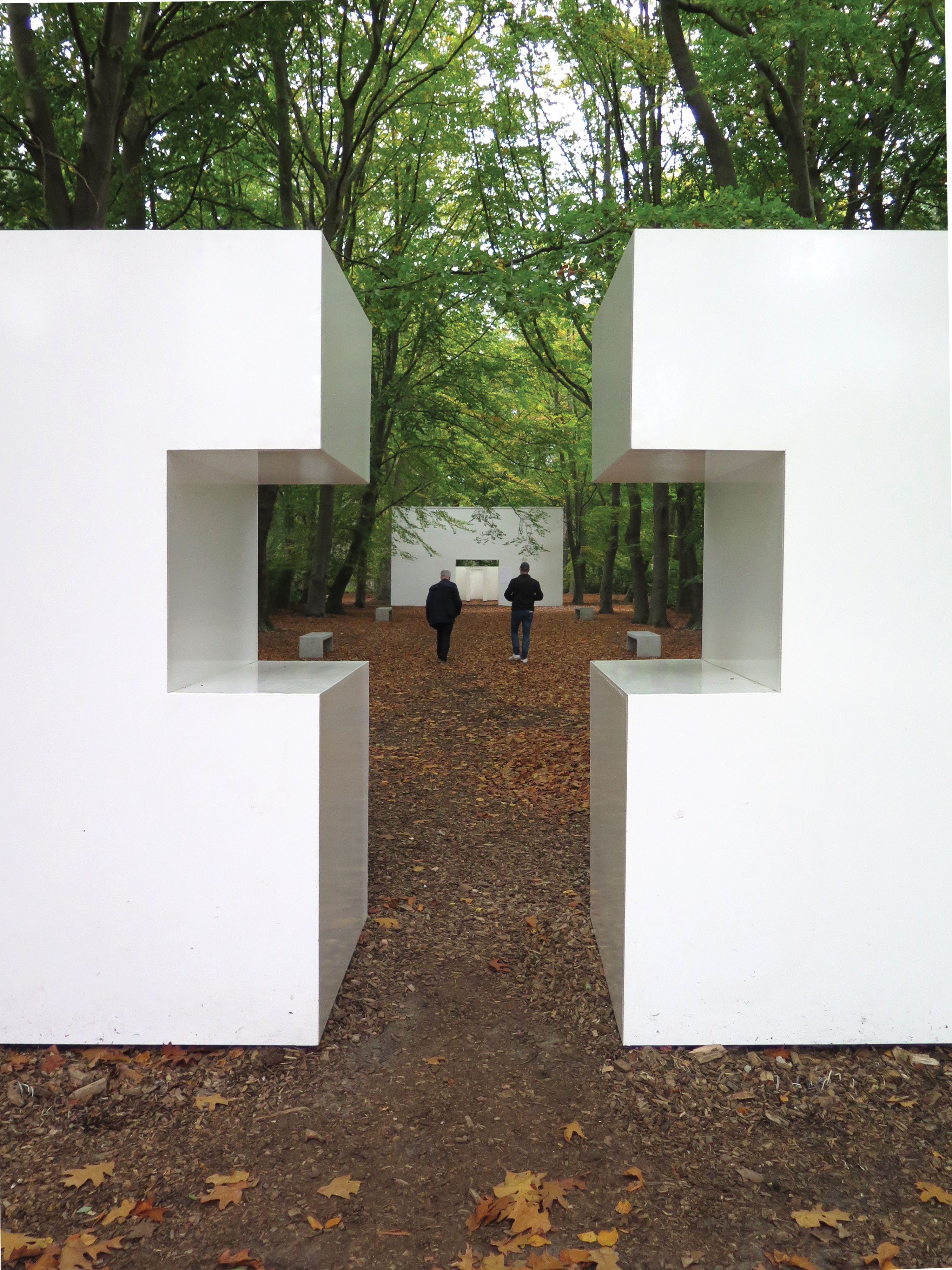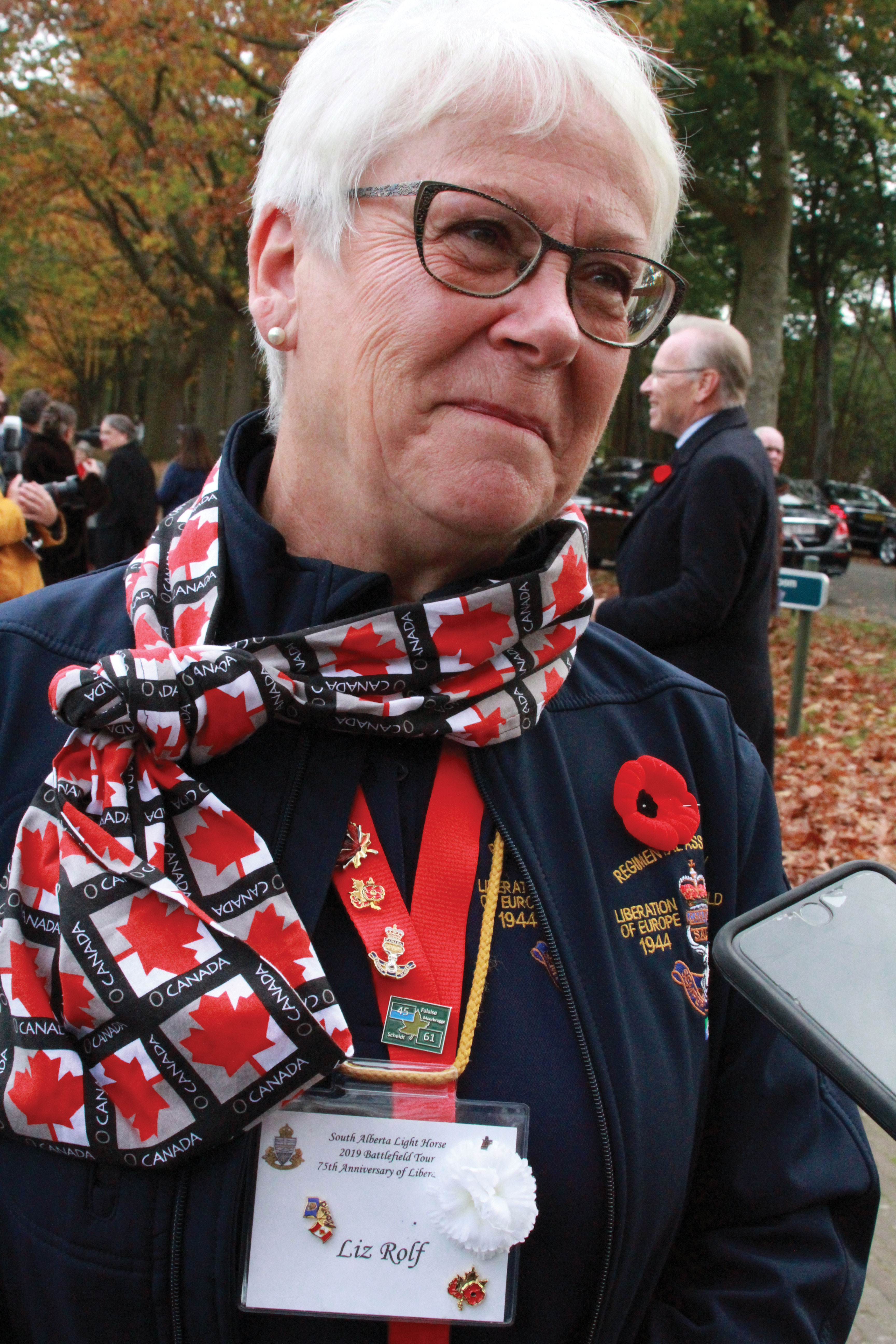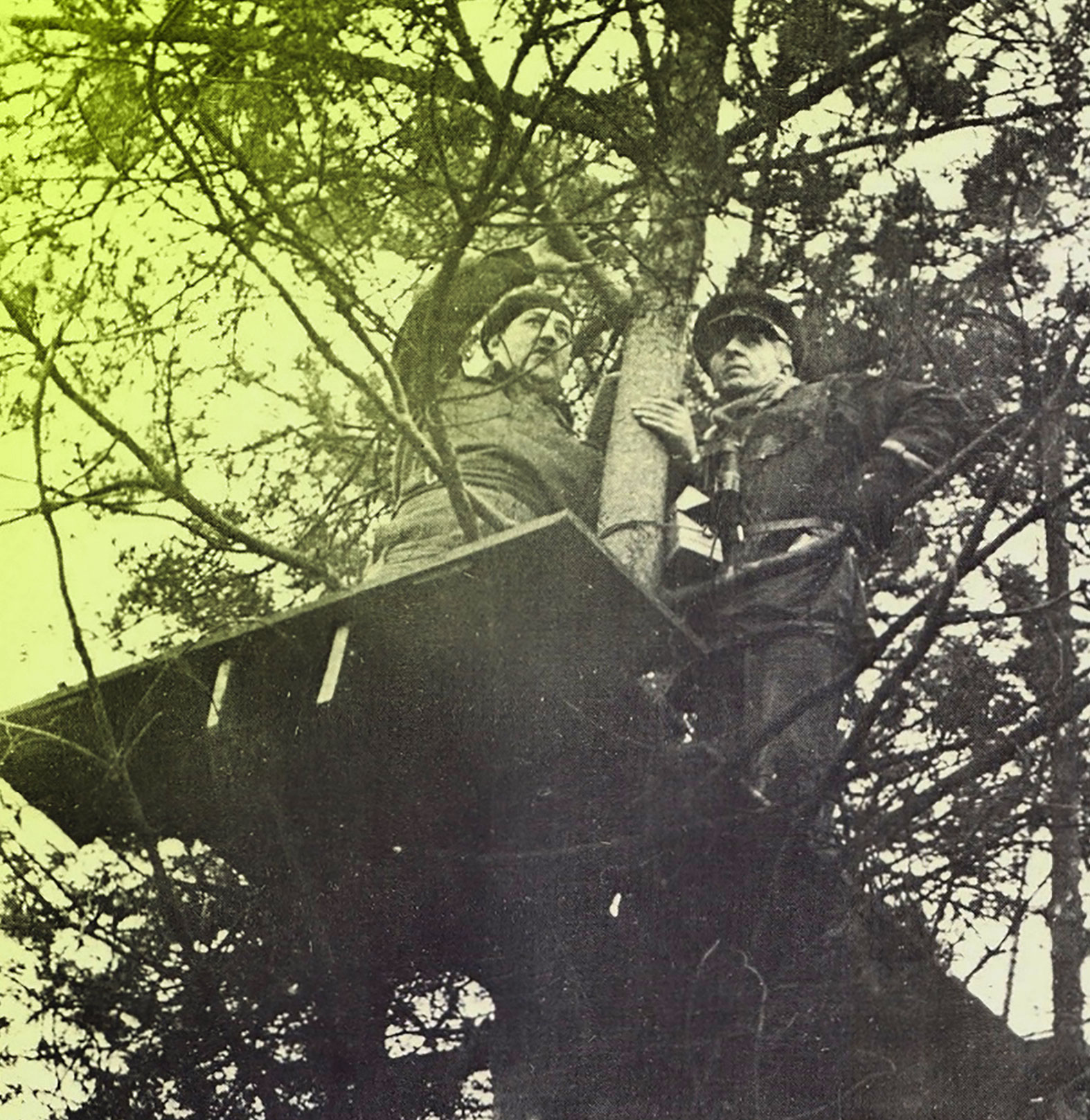
Two journalists approach the the Dilemma Maze near the Bergen-op-Zoom Canadian War Cemetery. [Dyann Bernard]

I take a breath, scoot to the edge of my seat—ready to exit the van and eager to investigate our next stop. I walk along Ruytershoveweg Road toward a tall white wall, set back from the street and seemingly out of place among the trees that surround it. The beautiful clean lines and balanced shape appeal to me; I like the contrast of white against the green forest backdrop.
It is peaceful here on the outskirts of Bergen op Zoom, Netherlands, on this October day and I am aware of the crunch of gravel and fallen leaves as I approach. I stand dead centre at the entrance to the Dilemma Maze, an interactive art installation, as our guide, Peter Stoop, asks the question, “What would you do?”
Located beside the Bergen-op-Zoom Canadian War Cemetery, this dynamic maze consists of a pattern of connecting white crosses, where visitors are presented with a series of life-changing choices at each intersection. Each choice determines the direction of the story and the route through the maze.
The storylines in the maze are inspired by 75 wartime experiences that altered lives forever—one for every year the Dutch have lived in freedom—collected by the Brabant Remembers program.
An excerpt adapted from Brabant Remembers, a collection of 75 personal, life-changing war stories from 75 locations in the Brabant region.
During the war, the Sicherheitsdienst, the Nazi intelligence agency, hunted down state enemies, including Jews, communists and resistance fighters. Some people tried to escape these investigations by fleeing to neutral territory or by hiding. Others didn’t take such precautions and lived with the great danger of being caught.
In 1937, the Bruining family moved to a house in Eindhoven in south-central Netherlands. Hajo worked at the Philips Physics Laboratory and his wife, Nora, took care of their four children at home. Eldest daughter Annette suffered from tuberculosis and was forced to spend her days in bed.
In 1942, Annette knew her father was sending messages to England from a box with all kinds of knobs and buttons. Hajo seemed to be co-operating in secret with the resistance. Annette was told, “Don’t say anything and don’t talk about it.”
In 1943, Hajo arranged a hiding place for a Jewish doctor named Betty Levi in the attic of Bruining’s house. Their secret resistance work put the family in jeopardy. One night, less than a year after Levi moved in, a hard knock came on the front door. It was Sicherheitsdienst agents looking for Hajo.
Annette was scared by all the noise. Nora came into her room: “I hid your father under the floor, but the door doesn’t close properly. The tarp is draped over it.” She picked up her half-asleep daughter and took her to another bedroom. “I’ll put you in your father’s bed because it’s still warm. Pretend you’re asleep.”
As Nora opened the front door for the agents, Annette saw her father’s transmitter. Nora tried to convince the agents that her husband was not at home, but it wasn’t working. Annette quickly hid the transmitter under the blankets and kicked it to the end of the bed, along with her father’s slippers, which had been lying by the bed. The men walked upstairs, the door opened and Nora pointed a torch at the bed. They pulled the sheet from Annette’s face. “This is my daughter,” Nora said. “She is very ill. She has tuberculosis.” The men immediately let go of the sheet. They wanted nothing to do with that!
They searched the rest of the house and when they went into Levi’s attic room, Nora quickly told them that Levi was the nanny. Levi was sleeping in bed and nothing but her blonde curls stuck out above the blankets. The agents believed the story and left. But the danger still wasn’t past.
The men didn’t intend to leave without finding Hajo. One stood guard at the front door, the other behind the house. Hajo remained hidden under the floor through the night. Nora turned off all the lights and lay next to Annette.
In the morning, Nora put the cat out through the front door. There was no one there. Then she took coal out of the shed behind the house, and there was no one to be seen there either. Hajo hurried outside, with their maid’s Bible under his arm, and joined the passersby on the way to church. That’s how he reached the Royal Psychiatric Hospital, where the director, one of Hajo’s friends, had him admitted as a patient to hide him from the Germans. Levi found another safe hiding place in Eindhoven.
Not long after, Eindhoven was liberated and Hajo returned home. Even then, the fear of danger loomed. The Ardennes offensive kept everyone in suspense. There was a great fear that the Germans would recapture Eindhoven. Immediately after the liberation of the Netherlands, Hajo was presented with an award from the British government in the Ridderzaal in The Hague and became a member of the Order of the British Empire.
Hajo said “The war is over,” and never spoke of it again. Levi emigrated to Israel and stayed in touch with the Bruining family.
I enter the maze alone through the first door. The space is no wider than a narrow closet and I immediately feel confined and mildly anxious. My heart starts pounding. Stark white walls surround me, and even though there is no roof, it is an uncomfortable environment. Each audio station within the maze presents a difficult choice.

The Dilemma Maze near the Bergen-op-Zoom Canadian War Cemetery challenges visitors. [Dyann Bernard]
I move forward, press the button and listen closely:
“Would you have fought for my freedom?”
My decision, A or B, determines the direction I move and which door I enter next. Just what would I do, faced with a situation where neither choice is right or wrong? It is tougher than I expect, but it is my decision all the same.
The visit to the Dilemma Maze is one stop on a four-day media tour hosted by Liberation Route Europe on the 75th anniversary of the Battle of the Scheldt and the liberation of the Netherlands.

Canadian and other Allied forces faced challenging terrain and brutal battles with German occupiers from the fall of 1944 to May 1945 and the end the Second World War. More than 7,600 Canadians died in the nine-month campaign to liberate the Dutch.
Our group of journalists—three Canadian and one Dutch—attended several special events and commemorations taking place throughout the Netherlands, including the official opening of the newly expanded Liberation Museum Zeeland, a wreath-placing ceremony at Monument Sloedam, and tours of the new Freedom Museum in Groesbeek and the Memory Museum in Nijverdal.

Crowds gather to watch the Freedom of the City parade in Bergen op Zoom. [Dyann Bernard]
On foot in the cobbled streets of Bergen op Zoom, I am struck by the size of the crowd gathered—some standing 15 deep—to cheer on the Freedom of the City parade as it weaves to the city centre for a ceremony in tribute to the Canadian soldiers who were first to liberate the city. Grandstands bordering the square are packed and many in the audience are waving small Canadian and Dutch flags.
The daylong festivities end with a tattoo including Canada’s Lincoln and Welland Regiment band. From my perch on the second floor of the town hall, I have a full view of the spectacle and the band performances. Canadian flags are on proud display in the square this night.
Commemorations continue the next day at the Memorial Day of Canada ceremony at Bergen-op-Zoom Canadian War Cemetery. Most of the Canadian soldiers buried here lost their lives fighting north of Antwerp during the Battle of the Scheldt, as the 2nd Canadian Infantry Division, with support from the 4th Canadian Armoured Division, worked to clear German forces from the northern banks of the Scheldt estuary. The cemetery contains 1,118 Commonwealth burials, 31 of which are unidentified.

Liz Rolf (right) says she is humbled knowing that Canadians are loved in the Netherlands. [Dyann Bernard]
While waiting for dignitaries to arrive and the ceremony to begin, our group happens to spot a fellow Canadian from Canmore, Alta., attending with a group from the South Alberta Light Horse regiment. It was fairly easy to spot Liz Rolf—proudly dressed head-to-toe in colours and symbols of Canadian pride.
“I feel pride in being associated with what the Canadians did in the Liberation of Europe,” she said. “Yet humility, as I did nothing. I am riding on the backs of all the young men and women who did it all. The ones who came home and the ones who, sadly, did not.
“Remembrance has forever changed for me…. I’m so thankful, so proud. It is very cliché. The words have been said over and over again. I am humbled knowing that, as a Canadian, I am held with love in strangers’ hearts.”
The solemn ceremony includes a moving performance of a song from the Dutch musical Oorlogswinter (war winter) by the Roncalli Scholengemeenschap Junior Musical Class, young Dutch singers who later place red Gerbera daisies at the base of the memorial. In her speech, Lisa Helfand, Canada’s ambassador to the Netherlands, quotes lyrics from “Pass It On,” a folk song she learned as a teenager.
Freedom doesn’t come like a bird on a wing
Freedom doesn’t come down like the summer rain
Freedom is a hard-won thing
You’ve got to work for it, fight for it,
day and night for it
And every generation’s got to win it again
Pass it on to your children, mother
Pass it on to your children, brother
Pass it on
As the ceremony comes to an end, young and old walk to the memorial and lay flowers in silence. These are small gestures of remembrance—yet are hugely impactful.

Students from the Roncalli Scholengemeenschap Junior Musical Class place flowers at the base of the memorial in the Bergen-op-Zoom Canadian War Cemetery. [Dyann Bernard]
‘Netherlands’ means low-lying country, so I was surprised to learn that the countryside, while remarkably level, isn’t completely flat. Much of the land is indeed below sea level, but as we travel farther east, the landscape starts to change with low, elongated ridges and hills (the Dutch call them mountains) and forested areas.
North of Groesbeek and within three kilometres of the German border, we arrive at a farm owned by the Langeveldt family. In October 1944, the family was forced to evacuate to a safe area, although Papa Langeveldt returned several times, without permission, to save belongings from being stolen.
A tree on the property was used by Allied forces as a lookout. This “Tree of Horrocks,” named for Lieutenant-General Brian Horrocks, commander of the British army’s XXX Corps, still stands today. From Sept. 17, 1944, to Feb. 8, 1945, the farm and surrounding area were attacked day and night by German positions.

Lieutenant-General Brian Horrocks, commander of the British Army’s XXX Corps, observes enemy movements from the “Tree of Horrocks” during the fighting near Groesbeek. [Private collection of Horrocks]
Five months after liberation, Papa Langeveldt returned to find the farm in ruins and the grassland filled with German S-mines, known as “Bouncing Bettys.” Langeveldt figured out how to locate the mines: the grass grew taller where they were buried. Once carefully retrieved, he stored them under a woodpile and used old roof tiles to make a temporary shelter. German prisoners of war, sent to the area to collect the S-mines, instead tossed a grenade into the woodpile, blew up the mines and destroyed the shelter. Son Theo Langeveldt and his family continue to live at the farm.
It is late afternoon. The setting sun casts a warm glow as we arrive at Groesbeek Canadian War Cemetery, situated close to the eastern Dutch city of Nijmegen. More than 2,300 Canadians are buried here, most killed during the Siegfried Line Campaign, including Victoria Cross recipient Aubrey Cosens of the Queen’s Own Rifles. The Groesbeek Memorial at the entrance to the cemetery contains the names of another 103 Canadians who have no known graves.

Our guide, Maarten Dekkers, tells us about Lance-Corporal Antonio Barbaro, a Canadian soldier buried in Grave III. D. 10. On Feb. 15, 1945, Barbaro, 22, and two other soldiers attempted to cross the Meuse River. A strong current and rough water caused their boat’s boom to punch a hole in the hull of the vessel. As the boat took in water, Barbaro decided to give the only two life jackets to his fellow soldiers, who could not swim. Being a strong swimmer, Barbaro thought he could make it to shore, but tragically he drowned. His body was recovered two months later.
“He sacrificed his life to give his companions a better chance to live,” the chaplain of his regiment wrote in a letter to his parents. “The war seems to the take the best among us.”
On April 18, 1945, Barbaro was buried at a temporary cemetery near a Bailey bridge in Mook, and in July 1946, he was reburied in the new Canadian War Cemetery in Groesbeek. In September 2014, the Antonio Barbaro monument was unveiled near a railway bridge in Mook. Dekkers has a view of the monument from his apartment.

The National Canadian Liberation Monument, known as The Man with Two Hats, symbolizes the bond between the Netherlands and Canada. [Dyann Bernard]
Travelling farther east into the forest-rich Veluwe region, we arrive at the Het Loo Palace in Apeldoorn, where the last Canadian headquarters was stationed at the end of the war. In the stables, now used as meeting rooms, we sit with Anita Menninga, chair of the Foundation Liberation Apeldoorn 1945, and the rest of the organizing committee. Extensive planning is well underway to celebrate 75 years of freedom in Apeldoorn and its nearby villages, including the Canadian Liberation Festival, May 9-10, 2020.
The National Canadian Liberation Monument is a short walk from the palace. On this spot, over a flagstone platform bearing the Canadian maple leaf, stands a 4.6-metre bronze figure with a hat in each hand, feet firmly planted on the ground and arms outstretched to the sky. The hats represent war and peace, repression and freedom, life and death, sadness and joy. Some say that if a Dutch man came out of the war with two hats instead of just one, he was lucky.

Sculpted by Dutch artist Henk Visch, De man met de twee hoeden (“The Man with Two Hats”) symbolizes the bond between Canada and the Netherlands. A twin statue, unveiled by Princess Margriet of the Netherlands on May 11, 2002, stands in Commissioners Park at Dow’s Lake in Ottawa. The statues are not completely identical though: Apeldoorn’s statue has painted eyes, Ottawa’s does not.
I exit the final door of the Dilemma Maze and try to let it all sink in. I am profoundly moved by this simple but very powerful ethical exercise. War thrusts impossible choices on people. This was the prevailing theme on this too-brief tour. Those personal stories—of inspiring, gut-wrenching and life-changing choices made by the Dutch people during the German occupation and by the brave, tenacious Canadians who fought to liberate them—will stay with me forever.

For information on Holland, visit: www.holland.com
For information on Liberation Route Europe, visit: https://liberationroute.com/
For information on Europe Remembers, visit: www.europeremembers.com
Advertisement





















